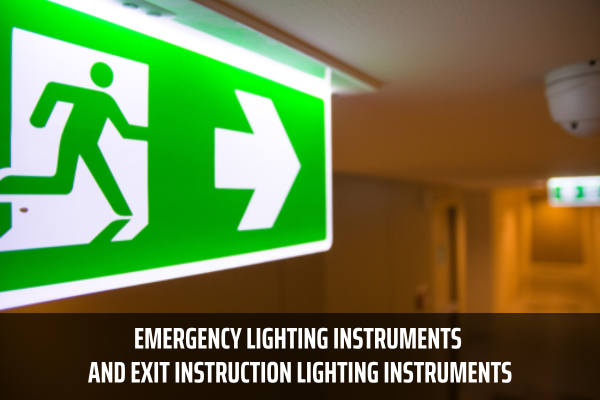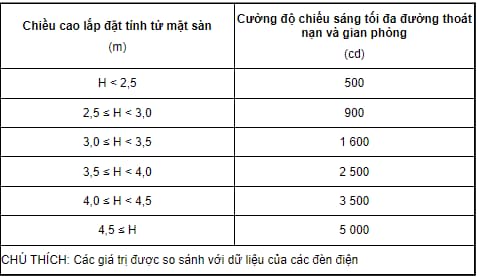National Standard TCVN 13456:2022: What are the regulations on design and installation requirements of emergency lighting instruments and exit instruction lighting instruments in Vietnam?
- What are the general regulations for the design and installation requirements of emergency lighting instruments and exit instruction lighting instruments in Vietnam?
- National Standard TCVN 13456:2022 : What are the regulations on the design and installation requirements of emergency lighting instruments in Vietnam?
- National Standard TCVN 13456:2022: What are the regulations on requirements for exit signs in Vietnam?
What are the general regulations for the design and installation requirements of emergency lighting instruments and exit instruction lighting instruments in Vietnam?
Pursuant to Section 4 of National Standard TCVN 13456:2022, the general regulations for the design and installation requirements of emergency lighting instruments and exit instruction lighting instruments are as follows:
- The design and installation of lighting instruments and exit instruction lighting instruments must comply with the requirements and regulations of relevant current standards, specifications, and norms.
- The means of emergency lighting instruments and exit instruction lighting instruments include emergency lighting instruments, safety signs, and exit diagrams.
- The means of emergency lighting instruments and exit instruction lighting instruments must be selected and equipped appropriately to ensure clear visibility for evacuation, provide clear instructions for escape routes, warn of potentially dangerous locations during evacuation, and identify locations equipped with fire prevention and fighting devices.
- The installation of emergency lighting instruments and safety signs must comply with the regulations of TCVN 7722-2-22:2013. When installing emergency lighting instruments and safety signs inside buildings, facilities, or construction projects with explosion hazards or high humidity, lights and signs that are explosion-proof or moisture-proof must be used.
- Emergency lighting instruments and safety signs with backup power supply must ensure continuous stable operation for at least 120 minutes in case of fire or explosion incidents.
- Safety signs must clearly display the words "LỐI RA" or "EXIT" and appropriate geometric symbols. The background color of safety signs is green, and the color of the words and geometric symbols is white.

National Standard TCVN 13456:2022: What are the regulations on design and installation requirements of emergency lighting instruments and exit instruction lighting instruments in Vietnam? (Image from the Internet)
National Standard TCVN 13456:2022 : What are the regulations on the design and installation requirements of emergency lighting instruments in Vietnam?
Pursuant to subsection 5.1 of Section 5 of National Standard TCVN 13456:2022 on the design and installation requirements of emergency lighting instruments, the following regulations apply:
(1) Emergency lighting instruments must be installed in the following areas of buildings and facilities:
- Staircases for emergency escape.
- Escape routes, areas of direction change, and intersections of corridors.
- Locations along escape routes with changes in elevation.
- Doors and exit routes.
- Parking garages.
- Workspaces and areas where the distance from the furthest point within the space to the nearest exit is greater than 13m.
- For spaces with designated escape routes, emergency lighting instruments may only need to be installed along those routes.
- Transformer rooms, generator rooms, elevator machine rooms, and refuge spaces.
- Fire control rooms, fire pump rooms, and other locations equipped with fire prevention and fighting devices.
In the following cases, emergency lighting instruments may not be required:
- Gardens and rooftop areas without overhead cover.
- Single-story buildings with a floor area not exceeding 200m2 and external wall openings covering at least 80% of the wall's surface.
(2) Emergency lighting instruments for escape routes:
For escape routes with a width up to 2m, the average illuminance horizontally on the floor surface along the center of the escape route must be equal to or greater than 1 lux, and the middle portion with a width greater than or equal to half of the escape route must have a minimum illumination of 50% of that value (refer to Figure A.2).
Note: Wider escape routes can be considered as multiple 2m wide sections or treated as open space lighting (anti-panic lighting).
(3) Emergency lighting instruments for rooms:
The average illuminance horizontally must not be lower than 0.5 lux on the floor surface at all points within the space, excluding a 0.5m border along the perimeter (refer to Figure A.3).
(4) The ratio between the maximum and minimum illuminance along the centerline of the escape route and the lighting of open spaces (anti-panic lighting) must not exceed 40:1.
Note: To demonstrate this ratio, the CIE S 015, Chapter 4.3.3, electrical network system should be used.
(5) Temporary glare risk must be minimized by limiting the light intensity during the maximum output phase of each lamp within the observer's viewing range during operation. To be specific:
- For lighting along escape routes horizontally, room lighting, and lighting for fire prevention and fighting devices, the light intensity of lamps within the angular range from 60° to 90° must not exceed the specified values in Table 1 (refer to Figure 1).
- For other escape routes, the light intensity of lamps must not exceed the values in Table 1 at any angle (refer to Figure 2).
Note: Improper placement of emergency lighting instruments may cause temporary blindness and hinder the vision of individuals during their movement towards safety.

Figure 1 - Temporary glare risk zone for horizontally lit escape routes

Figure 2 - Temporary glare risk zone for other escape routes
Bảng 1 - Giới hạn gây lóa tạm thời

(6) Central fire alarm panels, fire alarm buttons, and firefighting equipment must always be adequately illuminated for easy identification. If they are not located on escape routes or within open spaces, they must have a minimum illumination of 5 lux on the floor surface (refer to Figure A.4 TCVN 13456:2022).
National Standard TCVN 13456:2022: What are the regulations on requirements for exit signs in Vietnam?
Pursuant to subsection 5.2 of National Standard TCVN 13456:2022, the requirements for exit signs are as follows:
Exit signs must be installed at all entrances to emergency staircases, escape routes on floors, and all exits of rooms with two or more exit routes:
They may not be necessary in the following cases:
- For rooms equipped with emergency lighting instruments, one of the following conditions must be met:
+ There is only one entrance, or
+ There is a direct exit to a corridor or outdoor space.
- For rooms not equipped with emergency lighting instruments, one of the following conditions must be met:
+ There is only one entrance and the distance from any point in the room to the nearest exit does not exceed 7m, or
+ The distance from any point in the room to the entrance does not exceed 13m, and the minimum area of the wall adjacent to the corridor is 50% glass, and one of the following conditions is met:
++The door opens into a corridor with emergency lighting instruments, or
++The door opens to a side corridor or directly to the outside.
- For single-story buildings with a floor area not exceeding 200m2 and external wall openings covering at least 80% of the wall's surface.
LawNet